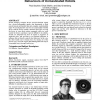292 search results - page 5 / 59 » Social Robotics and the person problem |
HRI
2009
ACM
14 years 2 months ago
2009
ACM
Several emerging computer devices read bio-electrical signals (e.g., electro-corticographic signals, skin biopotential or facial muscle tension) and translate them into computer- ...
EPIA
2007
Springer
14 years 1 months ago
2007
Springer
We present as a contribution to the field of human-machine interaction a system that analyzes human movements online, based on the concept of Laban Movement Analysis (LMA). The im...
HRI
2006
ACM
14 years 1 months ago
2006
ACM
This paper presents results toward our ongoing research program into hands-off assistive human-robot interaction [6]. Our work has focused on applications of socially assistive r...
ICRA
2000
IEEE
13 years 12 months ago
2000
IEEE
Potential function approaches to robot navigation provide an elegant paradigm for expressing multiple constraints and goals in mobile robot navigation problems 9]. As an example, ...
IROS
2009
IEEE
14 years 2 months ago
2009
IEEE
—Robust localization of robots and reliable tracking of people are both critical requirements for the deployment of service robots in real-world environments. In crowded public s...


